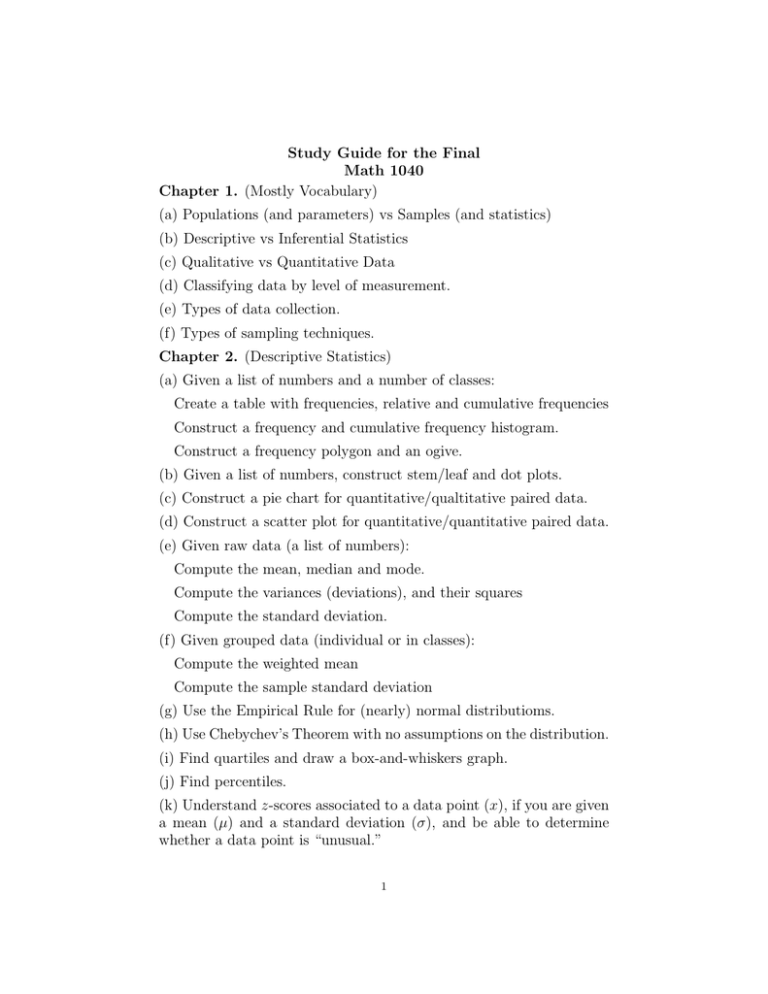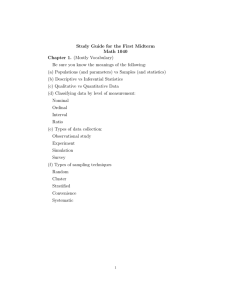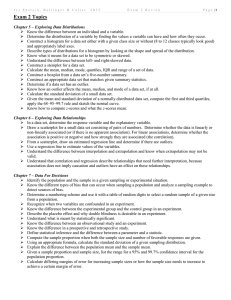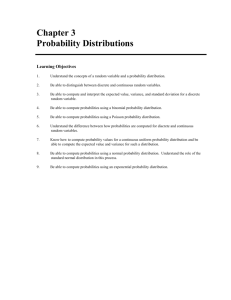Study Guide for the Final Math 1040 Chapter 1. (Mostly Vocabulary)
advertisement

Study Guide for the Final Math 1040 Chapter 1. (Mostly Vocabulary) (a) Populations (and parameters) vs Samples (and statistics) (b) Descriptive vs Inferential Statistics (c) Qualitative vs Quantitative Data (d) Classifying data by level of measurement. (e) Types of data collection. (f) Types of sampling techniques. Chapter 2. (Descriptive Statistics) (a) Given a list of numbers and a number of classes: Create a table with frequencies, relative and cumulative frequencies Construct a frequency and cumulative frequency histogram. Construct a frequency polygon and an ogive. (b) Given a list of numbers, construct stem/leaf and dot plots. (c) Construct a pie chart for quantitative/qualtitative paired data. (d) Construct a scatter plot for quantitative/quantitative paired data. (e) Given raw data (a list of numbers): Compute the mean, median and mode. Compute the variances (deviations), and their squares Compute the standard deviation. (f) Given grouped data (individual or in classes): Compute the weighted mean Compute the sample standard deviation (g) Use the Empirical Rule for (nearly) normal distributioms. (h) Use Chebychev’s Theorem with no assumptions on the distribution. (i) Find quartiles and draw a box-and-whiskers graph. (j) Find percentiles. (k) Understand z-scores associated to a data point (x), if you are given a mean (µ) and a standard deviation (σ), and be able to determine whether a data point is “unusual.” 1 2 Chapter 3. (Probability) (a) What is P (A)? What is P (A|B)? (b) Theoretical Probabilities: coin flips and cards. Tree diagrams. (c) Read empirical probabilities from a table. (d) The multiplication rule: P (A and B) = P (A|B) · P (B) What does it mean for A and B to be independent? (e) The addition rule: P (A or B) = P (A) + P (B) − P (A and B). What does it mean for A and B to be mutually exclusive? (f) Probability of the complement of an event: P (not A) = 1 − P (A). (g) Counting. Permutations and Combinations. n Cx n Px = the number of ways of choosing x objects from n objects = the number of ways of choosing x ordered objects from n Chapter 4. (Discrete Probability Distributions) (a) Compute expected values and standard deviations from a table. (b) What is a binomial experiment? What are n, x, p, q? Be able to use the formulas for P (x), mean and standard deviation. Chapter 5. (Normal Probability Distributions) (a) Review the conversion from x to z and back again. (b) Look up probabilities from z-scores and convert to percentiles. (c) Look up z-scores from probabilities (percentiles). Chapter 9. (Correlation and Regression) From a list of ordered pairs of data, (a) Review how to make the scatter plot. (b) Know what the correlation coefficient is telling you. (c) Use the formulas to compute the regression line (line of best fit). (d) Use the regression line to make predictions.




